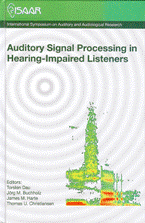Recognition performance on single-speaker recordings of W-22, NU6, and PB-50 by listeners with normal hearing
Abstract
The psychometric characteristics of the PB-50, CID W-22, and NU No. 6 monosyllabic word lists were compared with one another, with the CID W-1 spondaic words, and with the nine monosyllabic digits. The 583 words were spoken by the same speaker and were presented at 4 levels (−7-, −2-, 3-, and 8-dB S/N) in speech-spectrum noise xed at 72-dB SPL. Twenty-four young adults with normal hearing participated in four sessions. Recognition performance on the four lists within each of the three monosyllabic word materials were equivalent, ±0.4 dB. Likewise, word-recognition performance on the PB-50, W-22, and NU No. 6 word lists were equivalent, ±0.2 dB. The mean recognition performance at the 50% point with the 36 W-1 spondaic words was ∼6-dB better than mean performance on monosyllabic words. Recognition performance on the monosyllabic digits was 1-2 dB better than mean performance on the monosyllabic words.
References
Beattie, R. C., Edgerton, B. J., and Svihovec, D. A. (1977). “A comparison of the Auditec of St. Louis cassette recordings of NU-6 and CID W-22 on a normal hearing population,” J. Speech Hear. Dis. 42, 60-64.
Egan, J. (1948). “Articulation testing methods,” The Laryngoscope, 58, 955-991. Finney, D. J. (1952). “Statistical method in biological assay,” London, C. Griffen.
Hirsh, I. J., Davis, H., Silverman, S. R., Reynolds, E. G., Eldert, E., and Benson, R. W. (1952). "Development of materials for speech audiometry," J. Speech Hear. Dis. 17, 321-337.
Heckendorf, A. L., Wiley, T. L., and Wilson, R. H. (1997). "Performance Norms for the VA Compact Disc Versions of CID W-22 (Hirsh) and PB-50 (Rush Hughes) Word Lists," J. Am. Acad. Audio. 8, 163-172.
Kreul, E. J., Bell, D. W., and Nixon, J. C. (1969). “Factors affecting speech discrimination test difficulty,” J. Speech Hear. Res. 12, 281-287.
Lehiste, I., and Peterson, G. E. (1959). “Linguistic considerations in the study of speech intelligibility,” J. Acoust. Soc. Am. 31, 280-286.
Lovrinic, J., Burgi, E., and Curry, E. (1968). “A comparative evaluation of five speech discrimination measures,” J. Speech Hear. Res. 11, 372-381.
McArdle, R., and Wilson, R. H. (2007). “Interpreting Word-Recognition Data from the PB-50, W-22, and NU No. 6 Lists using the Neighborhood Activation Model and Phonemic Features of the Materials,” J, Am, Acad, Audio (under review).
Miller, G. A., Heise, G. A., and Lichten, W. (1951). “The intelligibility of speech as a function of the context of the test materials,” J. Exp. Psychol. 41, 329-335.
Peterson, G. E. and Lehiste, I. (1962). “Revised CNC lists for Auditory tests,” J. Speech Hear Dis. 27, 62-70.
Silverman S, and Hirsh, I. (1955). “Problems related to the use of speech in clinical audiometry,” Ann. Otol. Rhinol. Laryngo. 64, 1234-1244.
Tillman, T. W., and Carhart, R. (1966). “An expanded test for speech discrimination utilizing CNC monosyllabic words,” Northwestern University Auditory Test No. 6. Brooks Air Force Base, TX USAF School of Aerospace Medicine Technical Report.
Wilson, R. H., Coley, K. E., Haenel, J., and Browning, K. (1976). “Northwestern University Auditory Test No. 6: Normative and Comparative Intelligibility Functions,” J. Am. Audio. Soc. 1, 221-228.
Wilson, R. H. and Margolis, R. H. (1983). “Measurement of the auditory thresholds for speech stimuli”. in Principles of speech audiometry. Baltimore: University Park Press, 79-126.
Wilson, R. H., and Oyler, A. (1997). "Psychometric functions for the CID W-22 and NU Auditory Test No. 6 materials spoken by the same speaker," Ear. Hear. 18, 430-433.
Wilson, R. H., Zizz, C. A., Shanks, J. E., and Causey, G. D. (1990). "Normative data in quiet, broadband noise, and competing message for Northwestern University Auditory Test No. 6 by a female speaker," J. Speech Hear. Dis. 55, 771-778.
Additional Files
Published
How to Cite
Issue
Section
License
Authors who publish with this journal agree to the following terms:
a. Authors retain copyright* and grant the journal right of first publication with the work simultaneously licensed under a Creative Commons Attribution License that allows others to share the work with an acknowledgement of the work's authorship and initial publication in this journal.
b. Authors are able to enter into separate, additional contractual arrangements for the non-exclusive distribution of the journal's published version of the work (e.g., post it to an institutional repository or publish it in a book), with an acknowledgement of its initial publication in this journal.
c. Authors are permitted and encouraged to post their work online (e.g., in institutional repositories or on their website) prior to and during the submission process, as it can lead to productive exchanges, as well as earlier and greater citation of published work (See The Effect of Open Access).
*From the 2017 issue onward. The Danavox Jubilee Foundation owns the copyright of all articles published in the 1969-2015 issues. However, authors are still allowed to share the work with an acknowledgement of the work's authorship and initial publication in this journal.


